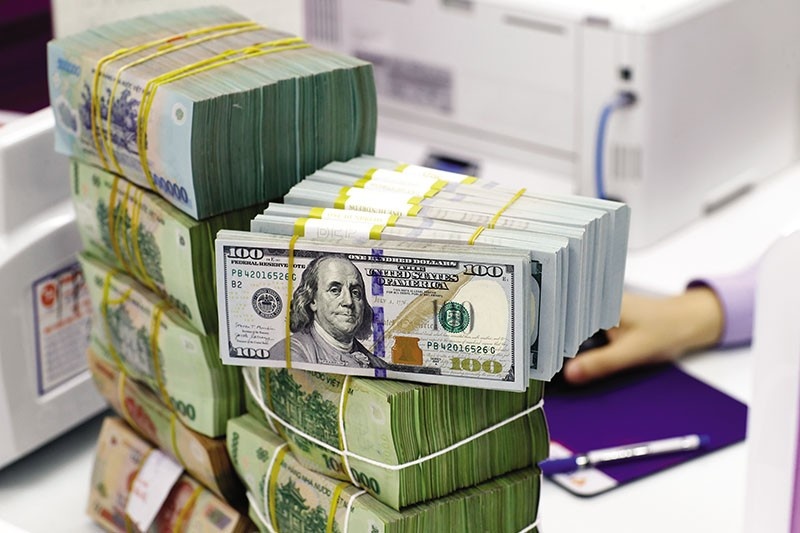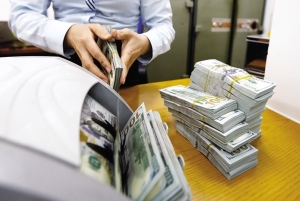Upward trend anticipated in forex rate
Tran Thi Khanh Hien, head of Research at MB Securities, opined that the USD/VND exchange rate has continually set new records as the gold price in the domestic market has shown no sign of going downward, and at its recent meeting on March 20, the US Federal Reserve decided on keeping interest rates intact, causing the difference between the USD-VND interest rates to continue to be extended.
 |
Looking back at the forex market landscape in the first quarter of this year, the USD/VND exchange rate in the interbank market surged about 2.2 per cent to around VND24,800 per USD.
The increase in the USD/VND exchange rate came right from the outset of the year, slowing down during Lunar New Year period and shortly resuming growth after the holiday.
These movements were fairly similar to those faced by some currencies in the region such as Japanese yen, which shed 7 per cent during the period, with Chinese renminbi down 2 per cent, South Korean won down 4 per cent, and Thai baht down 6 per cent.
A top senior leader at state lender BIDV assumed that the factors affecting the exchange rate in Q1 came from two directions.
First, on the international market, the DXY index which measures the USD strength inched up about 3 per cent to around 104.5. This is consistent with forecasts from the beginning of the year that the USD would not be abated as the US economy is on a strong growth path compared to other economies, such as the EU and China.
Second, domestically, the supply-demand balance is less abundant compared to the same period in the previous years.
Although some constituting components have been positive, such as the trade surplus reaching $8 billion, or FDI disbursement approximating $4.6 billion, up 7 per cent on-year, augmenting ‘cautious mentality’ has triggered the demand for foreign currency to hedge against a number of unfavourable factors in the international market, surging exchange rates in the unofficial market, and dwindled difference in the VND/USD interest rates.
“Amid surging exchange rate pressure, the State Bank made a move for market stabilisation through the T-bill channel, thereby narrowing the gap between VND-USD interest rates, helping to slow down the increase in domestic exchange rates at the end of the quarter,” said the BIDV leader.
In the second quarter, this executive insisted that the USD/VND exchange rate in the interbank market was still under pressure, although the increase might somewhat be limited thanks to the State Bank of Vietnam's intervention.
The USD/VND exchange rate might pick up by about 0.5-1 per cent in Q2 compared to the end of Q1. In the international market, the BIDV leader believes that the greenback will be affected by diverse factors.
Accordingly, the USD is strengthened by the positive outlook of the US economy compared to other counterpart economies.
The USD, however, is unlikely to increase strongly as recent Fed meetings showed a consensus view that the Fed would gradually lower the interest rates along the year.
The main oscillation zone of the DXY index is forecast to hover around the 103-106 range.
Domestically, the market sentiment continues to be cautious amid strong recovery in import demands, particularly from local businesses, and surging activities related to risk insurance and repatriation of profits would lead to not too abundant balance of foreign currency supply and demand in Q2.
Khanh Hien from MB Securities assumed that the USD/VND exchange rate would fluctuate in the range from VND24,400-VND24,600 in the forthcoming months thanks to diverse positive factors.
First, the government is taking action to stabilise the gold market.
Second, investors expect the Fed to reduce interest rates this year by about 85 basis points and this will narrow the difference between USD-VND interest rates, contributing to relieving devaluation pressure on the VND.
Third, positive macro factors persist, such as a positive trade surplus reaching $8 billion in Q1; disbursed FDI volumes touching $4.6 billion, up 7.1 per cent on-year; and strong tourism rebound as international visitors to Vietnam soared 72 per cent on-year in Q1, and up 3.2 per cent over the same period in 2019.
“Macro environment stability is likely to be maintained and further consolidated, which will be instrumental in ensuring a stable exchange rate in 2024,” said Hien.
 | Expert predictions on forex in 2024 Experts forecast a more moderate exchange rate movement in 2024 despite current stormy conditions. |
 | The upward wave of steel stock prices Steel stock prices have skyrocketed in 2023 and are projected to continue their strong upward trend in 2024, driven by robust public investments and a flourishing real estate sector that was boosted by the approved Land Law amendment on January 18. |
 | Forex market under significant pressure Large fluctuations in the forex market in the early months of this year have been contributed to several internal factors. Economic experts believe that measures so far have been insufficient, and market-driven interest rates are forecasted to rise in the near future. |
What the stars mean:
★ Poor ★ ★ Promising ★★★ Good ★★★★ Very good ★★★★★ Exceptional
Related Contents
Latest News
More News
- Tax sector wraps up 2025 and sets priorities for next year (December 25, 2025 | 14:00)
- A tipping point for digital and hybrid wealth management in Vietnam (December 23, 2025 | 13:33)
- $250 million deal targets women-owned SMEs, sustainable agriculture (December 22, 2025 | 17:40)
- Stock market posts resilient 2025 performance (December 19, 2025 | 18:17)
- Citi Vietnam receives 2025 AmCham CSR recognition (December 19, 2025 | 16:35)
- As global green supply chain reshapes, will Vietnam be left behind? (December 19, 2025 | 08:00)
- Banks gear up for massive capital increases (December 18, 2025 | 17:04)
- Securing capital and efficiency for Vietnam’s 2026-2030 growth ambitions (December 17, 2025 | 10:00)
- Energy sector in need of blended finance mechanisms (December 17, 2025 | 09:00)
- Vietnam still has room to mobilise capital for sustainable growth (December 17, 2025 | 08:57)

 Tag:
Tag:

























 Mobile Version
Mobile Version